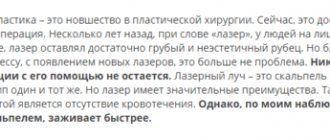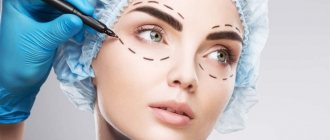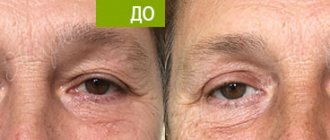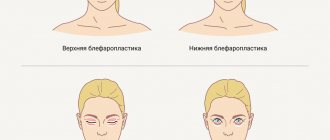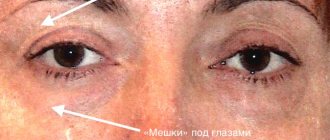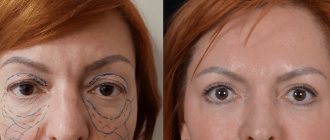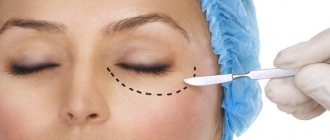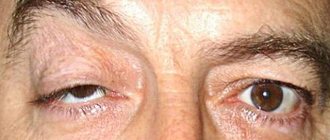Blepharoplasty
is an aesthetic surgery to correct eyelids, with which you can remove “bags” under the eyes (fatty hernias) and fill nasolacrimal grooves, remove excess skin - the effect of “overhanging” upper eyelids, correct asymmetry of the eyes, change their shape or cut.
Excess skin and fatty tissue in the periorbital area, drooping corners of the eyes and wrinkles make the face look more aged and the look “heavy”. Eyelid surgery is called a “small” operation with a spectacular result, since this minimal surgical intervention eliminates visible signs of age-related changes and makes the look more open, lively and expressive. The results of blepharoplasty last for years: there is no need to remove bags under the eyes again.
Caring for the skin of the periorbital area after surgery will help maintain its tone and consolidate the results of the operation.
Indications for blepharoplasty
Blepharoplasty allows you to make your appearance not only more youthful, but also attractive. Young people aged 20 to 30 undergo eyelid surgery to get a beautiful almond-shaped eye shape, get rid of congenital or acquired defects, signs of painful fatigue and swelling.
BLEPHAROPLASTY AT THE PIROGOV CLINIC IS AN OPERATION IN THE BEST PLASTIC SURGERY CLINIC IN ST. PETERSBURG.
*according to the ratings of the portals “Doctor Peter” and “Fontanka.ru” in 2021. Read more.
What effect can be achieved as a result of blepharoplasty?
- Remove wrinkles around the eyes (“crow’s feet”);
- Eliminate drooping upper eyelids (excess skin and fatty tissue);
- Remove “bags” under the eyes (fat bags);
- Fill the nasolacrimal groove;
- Raise the drooping corners of the eyes;
- Remove epicanthus;
- Correct ectropion of the lower eyelids;
- Correct asymmetry;
- Change the shape and shape of the eyes;
- Make your eyes visually larger and your look fresher.
Blepharoplasty performed by Egor Andreevich Parygin.
Contraindications
Eyelid surgery, like any surgical procedure, has contraindications. It is not recommended:
- for severe chronic diseases of the cardiovascular system, as well as renal and liver failure;
- bleeding disorders, hemophilia;
- diabetes mellitus (compensation stage);
- oncological diseases;
- periods of pregnancy and breastfeeding.
Relative contraindications include acute infectious diseases and elevated body temperature. It is recommended to perform the operation when the patient is completely healthy.
It is worth noting that surgery does not affect the eyeball, so people diagnosed with farsightedness, nearsightedness or other visual impairments can undergo surgery.
Types of blepharoplasty
Plastic surgeons at the Pirogov Clinic perfectly perform all types of eyelid correction operations.
We make sure that a beautiful and natural result pleases our patients for years, therefore we give preference to modern minimally invasive techniques and fat-preserving blepharoplasty .
The peculiarity of the latter is that during the operation, fatty tissue in the periorbital area is not completely removed, but is evenly redistributed under the skin. This allows you to maintain good skin quality - prevent aging, dryness, and avoid the “bulging eyes” effect. After blepharoplasty, lipofilling of the eyelids can be performed for the purpose of additional biorevitalization of the skin and correction of volume deficits.
Duration of results after surgery
It is important to understand that plastic surgery does not stop the natural aging processes. It removes their consequences for a certain period of time. Depending on the age at which the operation was performed, there is a possibility that it will need to be repeated. But, based on practice, it is carried out once. The result is stable and long-term – 7-15 years.
Dear girls, give yourself the gift of youth! To make an appointment, just contact the administrator by phone: + 38 (067) 634-81-20, or leave an online application.
Upper eyelid blepharoplasty
Upper eyelid surgery is prescribed for deep wrinkles
,
drooping corners of the eyes
and
sagging skin of the upper eyelid
, which makes the look seem tired. During the operation, excess skin of the upper eyelids and sometimes fatty tissue are removed. In this way, the soft tissues of the eyelids are tightened. After upper blepharoplasty, the look becomes more open.
Read more about the service
Here
Contraindications to upper blepharoplasty
Contraindications to blepharoplasty include only serious systemic diseases:
- Oncology;
- Diseases of the cardiovascular system;
- Impaired liver and kidney function;
- Poor blood clotting.
As for eye diseases, almost none of them are considered contraindications to surgery. The exception is inflammatory diseases such as conjunctivitis. It is worth noting that a temporary contraindication for surgery is any inflammatory process in the body.
Lower eyelid blepharoplasty
bags under the eyes once and for all
, swelling and folds.
Redistribution of the tissue of fat bags allows you to fill the nasolacrimal grooves
. Lower blepharoplasty may be the best solution for those who are tired of dealing with these defects using conservative methods.
Read more about the service
Here
Blepharoplasty: rehabilitation
The bandage from the face is removed three to five hours after surgery. For the first day after blepharoplasty, patients are recommended to remain in the hospital, under the close attention of a doctor. If there are no complications, discharge from the clinic is possible the next day. At first, you need to wear smoky (but not black) glasses.
If the patient has previously worn contact lenses, they should be discarded for seven to ten days. Glasses can be put on almost immediately, on the day of surgical correction.
In cases where the patient’s work activity does not involve heavy physical activity and long periods of time in front of a computer, he can go to work immediately after discharge. Physical activity provokes an increase in the intensity of blood circulation, as a result of which blood intensively flows into small vessels, incl. on the face. For this reason, it is important to avoid tilting your head down and eliminate any activities that involve keeping your head in this position.
To prevent the cornea from drying out, artificial tears should be used and drops should be instilled into the eyes every 30-60 minutes.
For the entire period of rehabilitation, it is necessary to abstain from drinking alcoholic beverages, coffee, and avoid playing sports and visiting the sauna and bathhouse.
For the first 7-10 days you need to follow a calm, gentle regimen. This does not mean a complete lack of physical activity. On the contrary, to speed up rehabilitation you need to walk in the fresh air, but at a calm pace and within reasonable limits.
Dietary restrictions after blepharoplasty include salty and spicy foods, which should be excluded to avoid salt retention in the body. You should not drink a lot of liquids that cause swelling.
Due to the static nature of the lower eyelids and the mobility of the upper eyelids, swelling in the upper eyelids subsides in a shorter time, and the disappearance of scars occurs faster in the lower eyelids.
On average, the recovery period lasts two weeks. During this time, swelling and bruising completely disappear in the eyes, and the use of cosmetics is allowed. To ensure that bruises disappear as quickly as possible, you must avoid exposing them to direct sunlight. If the operation was performed in the summer, it is recommended to use sunscreen, wear sunglasses, and a wide-brimmed hat to prevent sun exposure.
Circular blepharoplasty
The combination of blepharoplasty of the upper and lower eyelids will allow you to solve all problems at once during one operation.
The full scope of eyelid correction allows you to achieve the most pronounced effect. Circumferential blepharoplasty is often performed in conjunction with a facelift (facelift) or other anti-aging surgeries.
Read more about the service
Here
Who is the procedure suitable for?
Indications for intervention include age-related changes and congenital pathologies of the upper eyelid:
- loose overhanging skin;
- wrinkles, creases and folds;
- fatty hernias;
- overhanging soft tissues, provoking the effect of a sad and tired look;
- congenital or acquired asymmetry;
- hypertrophy of the circular muscles in the periorbital zone;
- swelling;
- turning of the eyelids.
In some cases, cosmetic imperfections cause both psychological and physical discomfort. Over time, upper eyelid ptosis can lead to blurred vision, drooping eyelashes, and eye irritation. The constant need to strain the facial muscles to keep the eyes open leads to the formation of wrinkles on the forehead, in the area of the nasolabial folds and other areas.
Contraindications:
- pregnancy and lactation;
- increased intracranial or intraocular pressure;
- myopathy;
- corneal infections;
- impaired blood clotting;
- oncological pathologies;
- exacerbation of chronic diseases and infections;
- rehabilitation after ophthalmological interventions.
| Facial plastic surgery – Dr. Amjad Al-Yousef | |
| Upper blepharoplasty (eyelid surgery) | 95,000 rub. |
| Eyelid surgery with canthopexy | RUB 105,000 |
| Upper eyelid surgery with asymmetry correction | RUB 105,000 |
| Facial plastic surgery - Anna Petrovna Pershukova | |
| Upper blepharoplasty (eyelid surgery) | 55,000 rub. |
| Upper eyelid surgery with asymmetry correction | 60,000 rub. |
| Facial plastic surgery - Dr. Youssef Bassanovich Dergam Prices include a promotion with a 50% discount with permission to publish the results of photos and videos | |
| Upper blepharoplasty (eyelid surgery) | 40,000 rubles instead of 80,000 rubles |
| Upper eyelid surgery with asymmetry correction | 45,000 rubles instead of 90,000 rubles |
| Facial plastic surgery - Dr. Ivan Pavlovich Chesalin Prices include a promotion with a 50% discount with permission to publish the results of photos and videos | |
| Upper blepharoplasty (eyelid surgery) | 40,000 rubles instead of 80,000 rubles |
| Upper eyelid surgery with asymmetry correction | 45,000 rubles instead of 90,000 rubles |
How is blepharoplasty surgery performed?
Duration of circular blepharoplasty – up to 1.5 hours
.
The operation takes place under local or general anesthesia. The plastic surgeon makes incisions in the natural folds of the skin of the upper eyelid and under the eyelash line (when correcting the lower eyelids). This provides access to the subcutaneous fatty tissue. After removing excess skin and fat, the surgeon applies stitches and a special bandage, which is removed 30 minutes after the operation. The length of hospitalization
after blepharoplasty ranges from 6 hours (in a day hospital) to 1 day in a ward, after which we discharge patients home.
Blepharoplasty
Promotion. From January 1 to January 31, 2022, the price for eyelid surgery is 26,900 rubles for 2 eyelids (instead of 30,000 rubles).
Blepharoplasty is the most frequently performed operation in aesthetic surgery in general and on the face in particular. The popularity of this operation is due to many factors. The main thing is that this is not such a decisive step as, for example, a circular facelift. The relative simplicity of surgery, short recovery period, minimal risk of possible complications and, finally, the price/quality ratio make blepharoplasty so popular. An important point is rapid social adaptation. After the operation, you will remain recognizable and, most likely (this happens in the vast majority of cases), your work colleagues will not notice anything, they will only note your refreshed appearance.
Age-related changes in the upper face include:
- drooping eyebrow;
- facial wrinkles on the forehead, glabella and periorbital area;
- sagging of the lateral edge, blepharochalasis and pseudohernia of the medial tissue of the upper eyelid.
- with deformation of the lower eyelid, the formation of a tear trough, pseudohernia of all three cellular spaces, as well as wrinkles is possible.
Blepharoplasty: what is it?
Eyelid surgery (blepharoplasty) allows you to remove excess skin, fatty tissue from the eyelids and bags under the eyes. Plastic surgery of both the upper and lower eyelids is possible. Blepharoplasty gives a pronounced cosmetic effect, because... The eyes are the most visible part of the face. The operation allows you to eliminate sagging skin and protruding subcutaneous fat, which give the face a tired, haggard appearance (this is especially true for lower eyelid surgery). Also, by removing excess skin folds of the upper eyelid, the field of vision can be expanded.
What should you expect from eyelid surgery?
Age-related changes in the skin of the face lead to sagging of the skin of the upper eyelids and a gradual limitation of the fields of vision above and on the lateral side. Hernias of fatty tissue are a common cause of bulging areas of the eyelids, creating the impression of swelling and bags above and below the eyes. Eyelid surgery removes excess tissue and skin. Also, with the help of blepharoplasty, you can eliminate folds of skin under the lower eyelids, but eliminating wrinkles in the temporal corner of the eye (“crow’s feet”) is not always possible.
Is blepharoplasty performed only on older people?
Eyelid surgery is possible both at the age of 30 and 80 years. The aging process and attitude towards one's appearance are individual. During the consultation, the doctor will help you determine the feasibility of the operation and make the right choice regarding its technique.
Is it possible to perform the surgery on an outpatient basis or is hospitalization necessary?
The procedure is carried out on an outpatient basis, because it does not require anesthesia, which can disrupt the patient’s respiratory activity. For blepharoplasty, a combination of local anesthesia with sedatives and painkillers is sufficient, if necessary. Only the procedure for administering local anesthetics causes discomfort.
How does the operation proceed?
The duration of the operation is 1.5-3 hours. Directly in the operating room, marks are applied to the skin of the eyelid with a special marker. After the operation, you will be able to go home. It is necessary to agree with someone who can accompany you, because... The medications you will be given during surgery may cause dizziness. Physical overexertion increases bleeding and bruising and should be avoided.
The duration of the operation is from 1 to 3 hours.
Will there be pain after the operation?
As a rule, there is no pain after surgery. It is recommended to rest more and move less in the first 48-72 hours after surgery. This reduces discomfort and bruising. There may be increased sensitivity of the skin in the corners of the eyes in the first days after surgery. In such a situation, paracetamol helps. Elevating the head while sleeping in the first days after surgery reduces swelling.
How is healing going?
The stitches are removed on the 5th day. The bruises will go away in two weeks. After two months, the fine lines of the stitches will turn white. Decorative cosmetics can be used a week after surgery. Even if the operation did not affect the lower eyelids, there will be slight bruising under the eyes after the operation. Slight tissue swelling is also characteristic. After surgery, a temporary weakening of the tone of the eye muscles often occurs; the eyes may remain slightly open during sleep. To prevent the cornea from drying out, apply a moisturizing eye gel before bed. A few weeks after surgery, the eyes sometimes feel dry. This is due to the fact that after removing excess skin, the eyes are more exposed to dust. Gradually you adapt to this, but to speed up the process you should blink more often.
How soon can I return to work and exercise?
As a rule, you can hide traces of surgery (bruises, scars) with hypoallergenic cosmetics 10 days after surgery; most patients return to work by this time. Moderate physical activity is allowed from the 7th day of surgery. You can return to long-term regular exercise, such as running, after 14 days if the postoperative period is calm.
How long will it take to see the results of the operation?
The result is noticeable immediately after the operation, but the final effect will appear after a few months.
Will the eyes look natural?
The purpose of eyelid surgery is to improve appearance. After surgery, patients look rested, more active and youthful for their age. Therefore, the overall appearance will be completely natural. Friends and acquaintances will certainly notice changes in your appearance, but most likely they will decide that the reason for your rejuvenation is the result of, for example, a good rest or a change in hairstyle.
What are the complications?
Such general surgical complications as suppuration, bleeding and the formation of a rough scar are possible here only hypothetically. Wounds after blepharoplasty heal quickly and on days 4-6 we remove the stitches; over the next 2 weeks you need to take care of the operated eyelids. Possible slight irregularities along the scar are associated with persistent local edema or differences in thickness, which are comparable after excision of excess skin and tissue and do not require additional correction. As the scar matures and the swelling of the eyelid skin decreases, the suture line will gradually smooth out.
How long does the effect of the operation last and will a repeat operation be necessary in the future?
The anti-aging effect of blepharoplasty lasts for decades, but do not forget that surgery cannot prevent natural aging.
What tests need to be done before surgery?
To perform the operation, after preliminary consultation, the following tests are required:
- blood for general analysis (expiration date 10 days)
- blood sugar test (expiration date 10 days)
- urine for general analysis (expiration date 10 days)
- Wasserman reaction (RW) (shelf life 10 days.)
- blood for antibodies to HIV, HBs antigen, hepatitis C (expiration date 1 month)
- blood for clotting according to Sukharev (shelf life 10 days)
Conclusions about the absence of contraindications to surgery:
- Endocrinologist (if you have diabetes).
Complete: fluorographic examination (expiration date 1 year), ECG (expiration date 1 month)
After receiving the results of all studies, undergo examination by a therapist
and obtain his conclusion about the absence of contraindications to the operation.
In 3 weeks Before surgery, stop taking aspirin and its derivatives 1 week. – eliminate alcohol, stop or reduce smoking as much as possible within a few days. Smoking reduces blood flow and thereby slows down wound healing. It is advisable to start taking vasoconstrictors two weeks in advance to reduce swelling in the postoperative period (ascorutin.) Before the operation, you should get a good night's sleep and rest - this will help avoid unnecessary nervous tension. On the day of surgery, have a light breakfast.
Reminder after blepharochalasis surgery
- Use painkillers and other medications only on the recommendation of a doctor;
- Sleep on a raised pillow;
- Avoid drinking alcohol for a week;
- Cold on the eyelids every hour for 10 minutes on the first day after surgery;
- Remove the patches after a week.
Prices
| n\n | service | cost |
| Correction of blepharochalasis (for 1 eyelid) | ||
| А16.26.022.01 | Correction of blepharochalasis (I degree of complexity) (1st eyelid) | 11500 |
| A16.26.022.02 | Correction of blepharochalasis (II degree of complexity) (1st eyelid) | 13500 |
| A16.26.022.03 | Correction of blepharochalasis (repeated up to 2 years) (1st eyelid) | 2000 |
Make an appointment
If you are going to visit our clinic, leave your phone number and our employee will call you back within 24 hours and make an appointment at a time convenient for you. If you need to ask a question to the doctor, then mark it in the note and the doctor will call you.
The application form is located on the left of each page of the site.
Appointment by phone, 202-20-28; +7 986-720-17-17.
With the simultaneous appearance of a depression in the zygomatic region, the so-called double bubble effect develops.
Most patients requiring blepharoplasty complain of a tired, haggard appearance, despite feeling well. Some complain of a subjective decrease in eye size. Women are often dissatisfied with the small width of the upper eyelid, which makes applying makeup impossible. With pronounced drooping of the upper eyelid, the field of vision on the temporal sides is limited. Bags under the eyes give the appearance of fatigue and are often combined with dark circles.
Blepharoplasty patients are mainly women aged 35 to 55 years. At a younger age, it is most often necessary to perform transconjunctival (through the inner surface of the lower eyelid) removal of hernial protrusions under the eyes. Older ladies more often require correction of sagging skin of the upper eyelid, both in combination with plastic surgery of the lower eyelid, and without it. But men also turn to us, mainly after 45 years - people with good looks, whose healthy and well-groomed appearance is the key to prosperity and well-being. I would like to emphasize that the requirements for eyelid surgery in men differ from those in women.
Patients should be examined before surgery. During the initial conversation with the surgeon, it is necessary to inform about all existing and past diseases, cases of drug intolerance, and allergic reactions. Particular attention is paid to the condition of the eyes.
Recovery after blepharoplasty
The patient can return to normal life the very next day after the operation; it is important to follow the recommendations of the plastic surgeon: apply ice at first, avoid ultraviolet radiation at high temperatures, and intense physical activity. Pain is usually not expressed. Stitches are removed within 4-6 days
after surgery, examined by a doctor. Bruises disappear within 14 days. You can speed up recovery and make it more comfortable with the help of a course developed by our plastic surgeons and cosmetologists.
Rehabilitation period
The postoperative period is short and usually takes no more than two weeks.
The sutures are removed within 3-5 days. After 7-8 days, you can use cosmetics. After surgery, physical activity is contraindicated for 2-3 weeks; a protective regime is recommended. If there are special indications, the patient may be prescribed physiotherapeutic treatment to speed up recovery.
The eyelid area is characterized by a favorable course of scarring processes, so you don’t have to worry about marks after surgery.
After complete healing, the patient has the opportunity to evaluate the final result of the operation. High-quality blepharoplasty gives a lasting effect, and therefore you don’t have to think about repeat surgery until after 10 years.
RESULT OF BLEPHAROPLASTY
Correction of the eyelids instantly transforms the appearance: the look becomes open and youthful, swelling, bags under the eyes, wrinkles, and sagging eyelids disappear. The result of the operation lasts for many years; recommendations for care and consolidation of the effect will be given by specialists from the Cosmetology Department of the N. I. Pirogov Clinic. For a quick recovery, cosmetologists select a program, after which you can quickly enjoy the result of the operation and demonstrate it to others.
Is blepharoplasty dangerous?
Blepharoplasty is a plastic surgery, so it must be performed by a highly qualified surgeon. The eyelid area and area around the eyes is a sensitive area with thin skin.
Many people who have indications for eyelid correction are afraid to have surgery because they believe in myths. For example, there is a fear that blepharoplasty will lead to worsening vision. However, doctors say the opposite. Temporary deterioration is possible due to swelling of the eyelids, but as the swelling goes away (2-3 days), vision will improve.
Sutures and marks from them also frighten patients. There is nothing to be afraid of here either, since the seam is made in the crease of the eyelid, which makes it as invisible as possible. Thin incisions also minimize surgical scars.
The patient can return to his normal lifestyle within 2 weeks after the correction.
Blepharoplasty: prices and reviews
The cost of the operation depends on the scope of correction and the qualifications of the plastic surgeon. Our clinic also has profitable promotions, you can find them in this section
. The cost of lower/upper eyelid blepharoplasty already includes: surgery, anesthesia, stay in the ward, postoperative patient care (examination by a surgeon, dressings and suture removal), consultation with a cosmetologist and one procedure of hardware lymphatic drainage massage
view reviews of blepharoplasty at the Pirogov Clinic
(St. Petersburg) in the corresponding section on our website.
Before the operation you must:
Undergo a clinical and laboratory examination prescribed by your attending physician.
The day before and on the day of surgery, do not use any cosmetics (eye cream, face cream, lipstick, etc.), or perfume.
Avoid alcohol three days before surgery.
2 weeks before surgery, exclude lemon and all aspirin-containing drugs, as well as any anticoagulants from food.
On the eve of the operation, you should wash your hair and face. Wash thoroughly immediately before surgery.
Three days before surgery, take Dicinon - 2 tablets 3 times a day, as well as another tablet in the morning on the day of surgery.
On the day of the operation, come to the clinic at the appointed time.
Why is it worth getting blepharoplasty at the Pirogov Clinic (St. Petersburg)?
- The Pirogov Clinic was recognized as the best plastic surgery clinic according
to the national rating of private clinics in St. Petersburg by the medical portal “Doctor Peter” and the city portal “Fontanka.ru” in 2022; - Our team of specialists includes experienced plastic surgeons, doctors of the highest category, winners of prestigious awards
- online consultations with plastic surgeons;
- free consultations with plastic surgeons;
- affordable prices for eyelid blepharoplasty;
- the opportunity to undergo all preoperative examinations in the clinic within one day;
- own laboratory: test results - quickly and with a guarantee of reliability;
- equipping operating rooms with the most advanced medical equipment from leading Western companies;
- attentive and responsible medical staff: a team of anesthesiologists, resuscitators, assistants and nurses coordinately and quickly resolves any issues around the clock;
- modern comfortable hospital: you feel like you are in a European hotel room;
- quick recovery after blepharoplasty;
- the ability to perform several operations simultaneously, which means you get the best result in one surgical intervention;
- the cosmetology and laser dermatology departments carry out procedures for the fastest possible tissue regeneration, allowing you to start enjoying the results as soon as possible;
- interest-free installment payment for any operations, credit;
- discounts on services under VHI policies.
Sign up for a consultation and we will help you find a new look!
Make an appointment
Preparing for blepharoplasty
I recommend starting with an in-person consultation. The plastic surgeon will see the overall picture and will be able to assess the condition of the skin and make recommendations. Consultations take place in Zaporozhye and Dnieper. I accept patients from all cities of Ukraine - Dnieper, Kherson, Lugansk, Donetsk.
We offer our out-of-town patients a combination of consultation, examination and surgery in 1 day! This is very convenient and also saves a lot of time.
Before the intervention, the patient undergoes tests - a general blood test, as well as coagulation tests. Based on the results, a decision is made to conduct it.
Transconjunctival (sutureless) blepharoplasty
The essence of the operation is that the surgical incision is located along the line of the conjunctiva, that is, on the inside of the lower eyelid. Hence the second name - “sutureless”, since sutures are not required after transconjunctival blepharoplasty: the dissected area located on the mucous membrane heals on its own.
In this regard, laser blepharoplasty is more profitable than traditional blepharoplasty - the surgeon removes excess fatty tissue through small punctures, which he makes with a laser beam. Under the influence of laser radiation, cellular processes are activated, provoking more intense tissue regeneration.
Accordingly, the rehabilitation period is significantly reduced: complete recovery occurs in three days, minor swelling and bruising disappear on their own within a week and a half.
In addition to all of the above, the laser is used by the surgeon to renew the skin of the lower eyelids, eliminate facial wrinkles and the first age wrinkles: after completing work on eliminating the hernia formation, the doctor performs laser resurfacing of the eyelids.
Laser transconjunctival blepharoplasty allows you to perform two operations in one operation: to eliminate a cosmetic defect in the form of fatty hernias and to tighten, make the skin of the lower eyelids more elastic and smooth.
It is recommended only for those patients who have not yet been diagnosed with age-related ptosis (tissue drooping) in the area under consideration, characterized by a significant amount of excess soft tissue.
To correct age-related aesthetic deficiencies in the periorbital area, more complex techniques are recommended that require large-scale surgical intervention using traditional surgical instruments.
You can learn more about transconjunctival blepharoplasty here
Progress of laser blepharoplasty surgery
The duration of the procedure is from 30 to 90 minutes (on average 45 minutes) and depends on the complexity and volume. Before performing the operation, I will select the appropriate technique to obtain the best results, taking into account your wishes, physiological characteristics and health status.
Step 1 - Anesthesia
Usually a combination of local anesthesia and light intravenous sedation is used, however, with a large volume of surgical intervention, the choice may fall towards general anesthesia. In our clinic, pain relief is always carried out under the guidance of one of the best anesthesiologists in the country, which guarantees your safety and the absolute safety of your health.
Step 2 - Cuts
The incision lines depend on the type of plastic surgery performed and are always located in the natural folds of the skin, which makes the seams and scars completely invisible to the prying eye!
Step 3 - Closing the Cuts
Sutures are usually closed:
- Removable or absorbable threads
- Leather glue
- Surgical tape
- When performing “seamless” laser transconjunctival plastic surgery, no sutures are required.
In the video: a 54-year-old patient diagnosed with hernias and excess skin of the upper and lower eyelids. Atony of the lower eyelids. In addition, the patient has a scleral gaze and a negative vector. In general, the conditions for blepharoplasty “cannot be worse.” Severe excess skin, hernias of the upper and lower eyelids are also visualized. The planned operation includes: circumferential blepharoplasty with myopexy and canthopexy in the lower eyelid area. This volume of surgery will minimize the risk of postoperative complications. A prerequisite for successful rehabilitation in such situations is anti-scar physiotherapy. As a rule, this is ultraphonophoresis with longidase.
Blepharoplasty: complications
Eyelid surgery is accompanied by the development of complications only in extremely rare cases. Complications that sometimes occur after surgical correction include:
- lagophthalmos (the patient cannot completely close the eyelids);
- dysfunctional tear syndrome;
- cicatricial curvature of the eyelids, etc.
One of the most severe complications is the appearance of retrobulbar hematoma. To prevent this problem, the surgeon carefully coagulates the vessels during the operation. The patient, in turn, two weeks before blepharoplasty should stop taking anticoagulants that provoke this complication. It is important to follow the postoperative regimen. If a retrobulbar hematoma occurs on the first day after surgery, it can be stopped quite easily in a hospital setting.
Thanks to a preliminary comprehensive examination and selection of the ideal surgical technique for each case, the doctors of the Sharm Gold clinic, who have impressive experience in the field of aesthetic surgery, manage to minimize possible risks. Plastic surgeons have innovative techniques in the field of aesthetic medicine, which guarantees the achievement of the desired result without negative consequences.
Benefits of laser blepharoplasty
The laser blepharoplasty procedure is performed using a CO2 laser, which has a number of obvious advantages compared to a scalpel:
Its beam is transparent, which allows the surgeon to fully see the operated area (unlike traditional blepharoplasty, when the surgeon partially covers the operated area with a scalpel).- It cuts the tissue layer by layer (the depth of each cut is 2-3 mm), which significantly reduces the risk of damage to the eyeball, cornea and eyelashes.
- It has pronounced coagulating properties: the radiation “seals” small blood vessels at the incision sites, minimizing bleeding of the operated area. This not only reduces the recovery period, eliminating swelling and bruising, but also helps the surgeon during the operation. The absence of blood allows him to clearly see the operated area, which makes laser blepharoplasty safer and faster than traditional blepharoplasty.
- Under the influence of laser radiation, cellular processes are activated, provoking more intense tissue regeneration, which reduces rehabilitation time by almost 2 times
- If there are fine wrinkles in the lower eyelid area, the procedure may be accompanied by laser resurfacing. The combination of these procedures makes it possible to achieve comprehensive rejuvenation of the lower eyelid area, which is not achievable with traditional intervention. Laser eyelid resurfacing is a technology of the future that is in service at our clinic.
Despite the obvious advantages, there are opponents of this method of eye rejuvenation. Basically, they appeal to the fact that the scalpel allows you to make a more even cut.
As a rule, I combine different techniques and I must note that despite the fact that the recovery period after laser blepharoplasty is shorter, the result of the operation, no matter how it is performed, will be the same.
Eyelid surgery can be performed either in combination with other anti-aging procedures (for example, facelift) or independently.

